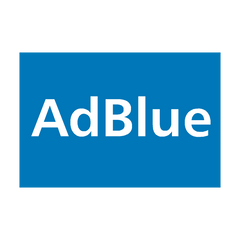AdBlue - How does it affect my vehicle?
Apr 07 2020 0 Comments Tags: AdBlue, AdBlue Vehicle Information, AdBlue Vehicle Stickers
AdBlue was created back in 2009 by a company called Tetrosyl under the branding name of Carlube. In September 2015, car manufactures such as Audi, BMW Land Rover and many others introduced AdBlue to their vehicle ranges to help reduce emissions. Lots of new vehicles use AdBlue and will need normally need topping up when the vehicle service is due.
AdBlue is widely recognised as a Diesel Exhaust Fluid ( DEF) and it is easily mistaken as a fuel additive. This fluid has a separate tank which is normally located in the boot or under the bonnet of a vehicle. A Blue filler cap is usually used to identify this tank on a vehicle.
AdBlue is manufactured using a mixture of non-toxic mixture of urea and de-ionised water. Surprisingly this fluid is colourless and does not contain any Blue colouring which is slightly misleading due to its name! There is a common tale where lots of people think this solution is made from Pig urine. However, this fluid is a highly pure man-made solution.
So how does AdBlue work in your vehicle? AdBlue is injected directly into the flow of hot exhaust gases which then transforms into ammonia and Co2. In the next stage of the combustion process, the ammonia then reacts with nitrogen oxide in the SCR catalyst ( Selective Catalytic Reduction ). This chemical reaction between the nitrogen oxide and ammonia converts this to harmless nitrogen and water.
When your vehicle is running low on AdBlue, a message normally illuminates on the dashboard with around 1000 to 1500 miles of range left. If a vehicle runs out of Adblue, the engine performance will be dramatically reduced in order to limit its emissions. A vehicle can not be restarted if the AdBlue tank is empty.
The rate of consumption for AdBlue normally depends on the engine size and how efficiently and economically you drive. Average consumption is normally a litre of AdBlue every 400 to 700 miles. The AdBlue tank size normally varies between each type of vehicle which means the mileage range can be from 2500 miles up to 12,500.
For more content, why not check out our other articles on our Blog: https://www.safety-label.co.uk/blogs/news
Thanks for reading this article, please see below for our range of AdBlue stickers.
AdBlue Stickers
0 Comments


Leave a Comment